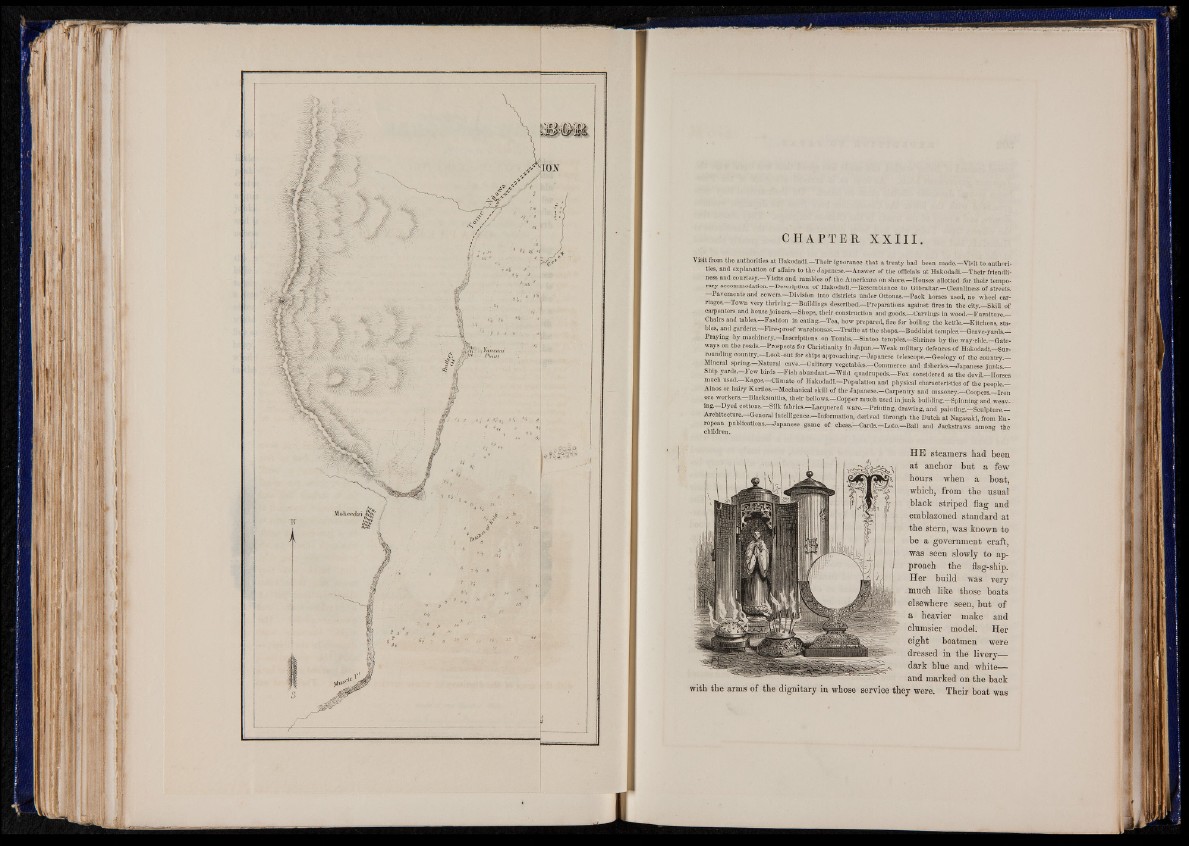
CHAPTER XX I I I .
Visit from the authorities at Hakodadi.—Their ignorance that a treaty had been made.—Visit to authorities,
and explanation of affairs to the Japanese.—Answer of the officials at Hakodadi.—Their friendliness
and courtesy. Visits and rambles of the Americans on shore.—Houses allotted for their temporary
accommodation.—Description of Hakodadi.—Resemblance to Gibraltar.—Cleanliness of streets.
—Pavements and sewers.—Division into districts under Ottonas.—Pack horses used, no wheel carriages.—
Town very thriving.—Buildings described.—Preparations against fires in the city.—Skill of
carpenters and house joiners.—Shops, their construction and goods.—Carvings in wood.—Furniture.—
Chairs and tables.—Fashion in eating.—Tea, how prepared, fire for boiling the kettle.—Kitchens, stables,
and gardens.—Fire-proof warehouses.—Traffic at the shops.—Buddhist temples.—Grave-yards.—
Praying by machinery.—Inscriptions on Tombs.—Sintoo temples.—Shrines by the way-side.—Gateways
on the roads.—Prospects for Christianity in Japan.—Weak military defences of Hakodadi.—Surrounding
country.—Look-out for ships approaching.—Japanese telescope.—Geology of the country.—
Mineral spring.—Natural cave.—Culinary vegetables.—Commerce and fisheries.—.Japanese junks.—
Ship yards.—Few birds—Fish abundant—Wild quadrupeds.—Fox considered as the deviL—Horses
much used.—Kagos. Climate of Hakodadi.—Population and physical characteristics of the people.—
Ainos or hairy Kuriles.—Mechanical skill of the Japanese.-Carpentry and masonry.—Coopers.—Iron
ore workers.—Blacksmiths, their bellows.—Copper much used in junk building.—Spinning and weaving.—
Dyed cottons.—Silk fabrics.—Lacquered Mare.—Printing, drawing, and painting.—Sculpture.—
Architecture.—General intelligence.—Information, derived through the Dutch a t Nagasaki, from E u ropean
publications.—Japanese game of chess.—Cards.—Loto.—Ball and Jackstraw's among the
children.
HE steamers had been
at anchor hut a few
hours when a boat,
which, from the usual
black striped flag and
emblazoned standard at
the stern, was known to
be a government craft,
was seen slowly to approach
the flag-ship.
Her build was very
much like those boats
elsewhere seen, hut of
a heavier make and
clumsier model. Her
eight boatmen were
dressed in the livery—
dark blue and white—
and marked on the back
with the arms of the dignitary in whose service they were. Their boat was